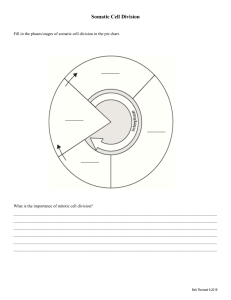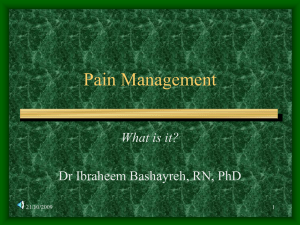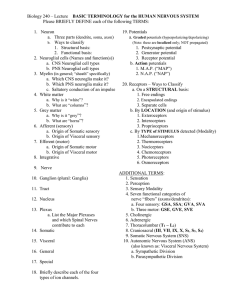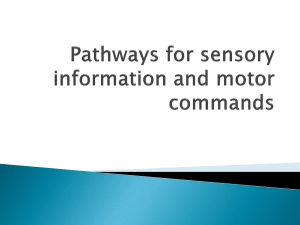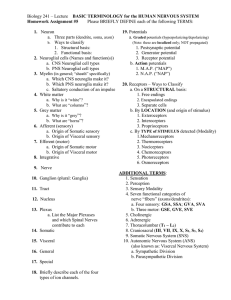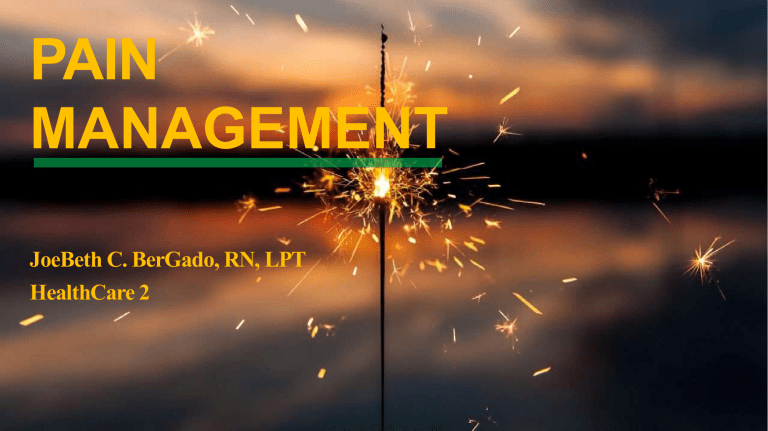
PAIN MANAGEMENT JoeBeth C. BerGado, RN, LPT HealthCare 2 2 CONTENTS 1 INTRODUCTION CLASSIFICATION TYPES 3 2 4 5 PAIN ASSESSMEN T TREATMENT 3 1 INTRODUCTION Introduction Definition : An unpleasant sensory and emotional experience associated with actual or potential tissue damage. Pain may not be directly proportional to amount of tissue injury. Highly subjective, leading to undertreatment 4 5 In cancer, the prevalence of pain in advanced disease is 70-90%. " In HIV disease, pain prevalence is about 50%. " Other illnesses may have significant pain but no clear data. 6 2 CLASSIFICATION Classification I. Acute II. Chronic : i. Non malignant ii. Malignant 7 Acute Pain Injury, trauma, spasm or disease to skin, muscle, somatic structures or viscera; Perceived and communicated via peripheral mechanisms (pathways) Usually associated with autonomic response as well (tachycardia, blood pressure, diaphoresis, pallor, mydriasis (pupil dilation). 8 Cont. Usually subsides quickly as pain producing stimuli decreases Associated with anxiety-(decreases rapidly) Can be understood or rationalized as part of the healing process. 9 II. Chronic Pain i. Non-malignant Pain persists beyond the precipitating injury Rarely accompanied by autonomic symptoms Sufferers often fail to demonstrate objective evidence of underlying pathology. Characterized by location-visceral, myofacial, or neurologic causes. 10 II. Chronic Pain ii. Malignant Has characteristics of chronic pain as well as symptoms of acute pain (breakthrough pain). Has a definable cause, e.g. tumor recurrence In treatment, narcotic habituation is generally not a concern. 11 12 3 TYPES OF PAIN Types of Pain Somatic Visceral Bone Neuropathic Emotional/Spiritual 13 I- Somatic Pain o o Aching, often constant May be dull or sharp Often worse with movement Well localized Skin, Muscle, Joints, superficial or deep. Eg: Bone & soft tissue chest wall 14 II- Visceral Pain Constant or crampy Aching, burning Poorly localized Referred Organs of Thorax & Abdominal Cavity. Usually as a result of stretching, infiltration and compression Eg: o Liver capsule distension o Bowel obstruction 15 16 Both Somatic & Visceral pain travel along the same pathways. Pain stimuli arising from the viscera is perceived as somatic in origin. This can be confused by the brain and is often described as referred pain. III- Bone Pain Poorly localized, aching, deep, burning. Common with malignancy of Breast, Lung, Prostate, Bladder, Cervical, Renal, Colon, Stomach and Esophagus Can lead to pathological fractures. Vertebral Metastases can lead to cord compression. 17 IV- Neuropathic Pain Caused by disturbance of function or pathological changes in a nerve. May arise from a lesion or trauma, infection, compression or tumour invasion. Described as burning, shooting, tingling. Does not respond well to standard analgesics. 18 Categories of Pain Classified by inferred pathophysiology: I. Nociceptive pain (stimuli from somatic and visceral structures) II. Neuropathic pain (stimuli abnormally processed by the nervous system) 19 20 I. Nociceptive: Caused by invasion &/or destruction &/or pressure on superficial somatic structures like skin, deeper skeletal structures such as bone & muscle and visceral structures and organs. Types: superficial somatic, deep somatic, & visceral. 21 II. Neuropathic: Caused by pressure on &/or destruction of peripheral, autonomic or central nervous system structures. Radiation of pain along dermatomal or peripheral nerve distributions. Often described as burning and/or deep aching & associated with dysesthesia or lancinating pain. Effects of pain o o o o o o Sympathetic responses Pallor Increased blood pressure Increased pulse Increased respiration Skeletal muscle tension Diaphoresis 22 Effects of pain o o o o o o Parasympathetic responses Decreased blood pressure Decreased pulse Nausea & vomiting Weakness Pallor Loss of consciousness 23 24 4 Pain Assessment Pain History The site of pain Type of pain Exacerbating & Relieving factors How frequently Impact on daily life 25 Pain History Other important additional questions to be asked. o What is the response to past and current analgesic therapy? o Any kind of diary or record about the pain? o Fears they have about analgesics? 26 PAIN ASSESSMENT Tools Verbal Analogue Scales. Visual Analogue Scales. The Faces Scale 27 Factors to consider in choosing a pain scale 1. 2. 3. 4. 5. Age of patient Physical condition Level of consciousness Mental status Ability to communicate 28 Numeric Pain Rating Scale Ask the patient to rate their pain intensity on a scale of 0 (no pain) to 10 (the worst pain imaginable). Some patients are unable to do this with only verbal instructions, but may be able to look at a number scale and point to the number that describes the intensity of pain. 29 Numeric Pain Rating Scale 30 Wong-Baker FACES Pain Rating Scale Can be used with young children (sometimes as young as 3 years of age) Works well for many older children and adults as well as for those who speak a different language Explain that each face represents a person who may have no pain, some pain, or as much pain as imaginable. Point to the appropriate face and say the appropriate description. e.g. “This face hurts just a little bit” 31 Wong-Baker FACES Pain Rating Scale Ask the patient to choose the face that best matches how she or he feels or how much they hurt. 32 Color Pain Rating Scale Ask the patient to point to the area on the scale that shows their level of pain from white (no pain) to dark red (worst possible pain). Obtain a number corresponding to the area where the patient points. 33 Severity Assessment McGill Pain Questionnaire Scale from 0 to 5 From None to Severe Pain for children or adults who understand numerical relationships. 34 PAIN ASSESSMENT Tools 35 36 5 Pain Treatment Goals of Pain Management Therapy 1) 2) o o 3) o o Decreased pain Decreased healthcare utilization Decreased “shopping” for care Decreased emergency room visits Improved functional status Increased ability to perform activities of daily living Return to employment 37 Management Non-Pharamcological treatment Pharmacological treatment: Analgesics Adjuvants Others 38 Thanks for Coming
